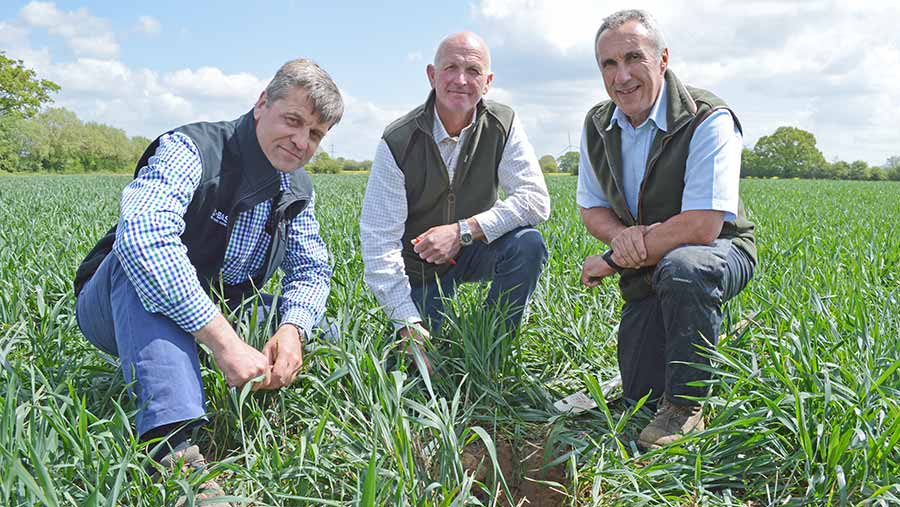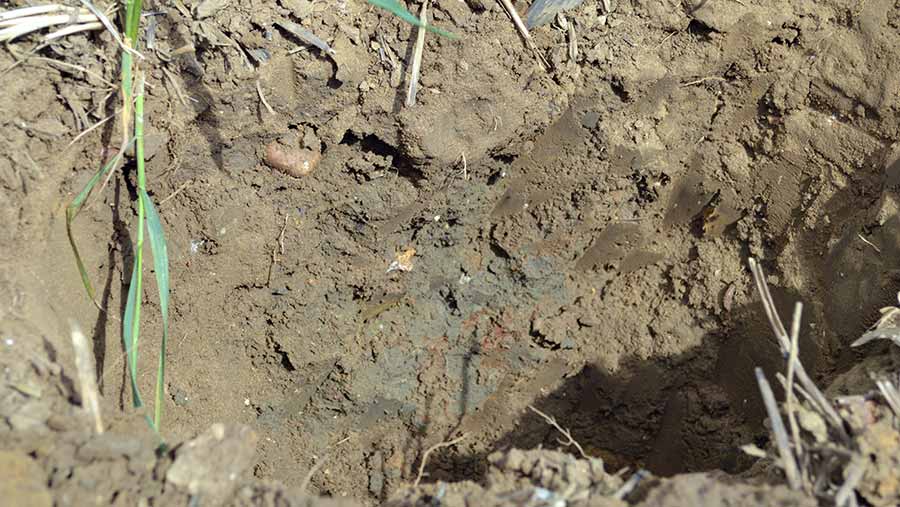Blackgrass battle looks winnable for Suffolk grower

Suffolk grower Andrew Colchester has taken a big step towards banishing blackgrass on his farm by radically changing his cultivation strategy and beefing up his herbicide programme.
He had seen the pernicious grassweed take a firm hold on his farm during the past decade, hitting his yields. He realised a dramatic change was needed last autumn.
On one trial field he abandoned his plough, delayed his winter wheat drilling and used a comprehensive herbicide spray policy and now he is hard-pressed to find any blackgrass this spring.
“We can’t just rely on chemicals, as we have tried this over the past 10 years and it does not work,” he tells Farmers Weekly.
New approach
Therefore, he gave his usual plough and power harrow approach a break this season for his chosen 7ha field and went for a light cultivation, drilled it with winter wheat on 16 October and held his breath.
See also: Autumn wheat drilling delayed to battle blackgrass
In hindsight, it was probably the worst season to try a new approach, as his late drilling was followed by one of the wettest winters on record. This stressed his wheat plants, but now, well into a warm spring, they have recovered.
“I am looking for blackgrass, but I can’t see any and I am more confident that I am not going to see it this season,” he says.
Mr Colchester farms 75ha at Church Farm, Thrandeston, north Suffolk, two miles south of Diss, on sandy clay loams that can run to heavier land, where the blackgrass flourishes.
Establishing cereals
He is a third-generation farmer, taking over the land from his father in 1991, and his traditional approach to establish winter cereals is a plough-press followed by a power harrrow-drill combination, with everything in the ground before his birthday on 28 September.
But as he contemplated spraying off some of his winter wheat last summer because of a heavy blackgrass infestation, he knew he had to change, and change quickly.
So with the help of Hugo Pryce, local agronomy manager at agrochemical giant BASF, he decided to take radical steps on his chosen field, as part of the group’s trial arable weed control programme.
The wet weather at harvest 2017 meant the combining of the previous spring barley crop and the baling and carting of straw had left the field badly damaged by machinery.
Low soil disturbance
So a disc-tine-roller low-soil-disturbance cultivator was used to level the field on 9 September. The stubble was left to green up and then sprayed off with glyphosate three to four days before drilling with a low-soil-disturbance disc drill.
A comprehensive herbicide programme, costing up to £80/ha, was used on the trial field, including pre-emergence chemistry aimed at controlling blackgrass.
One expert brought in to advise on this arable weed control trial was independent soils and cultivations specialist Philip Wright.
His first comment was that there was too much ploughing on the farm, as the key to improving soil structure and also controlling blackgrass was low-disturbance operations.

Anaerobic soil

Well-structured soil
Use of plough
He advises to plough only once in every four to five years, because if the plough is used every year, growers are resetting their soil structure each year and bringing up buried blackgrass seed.
The Sumo disc-tine-roller cultivator operated at a depth of 175-200mm, and was ideal to loosen the ground, but not bring blackgrass seed to the surface. The Weaving disc drill worked well due to its low-soil-disturbance characteristics.
If another winter cereal is planned after the wheat, Mr Wright advises following the same route as before, and the first cultivation can even by omitted if the harvest is dry and the stubble is in good condition.
“This has been encouraging for soil structure and encouraging for grassweed control, so it is a win-win situation,” says Mr Wright.
Church Farm, Thrandeston |
|
| Previous cropping | Spring barley |
| Drilling date | 16 October 2017 |
| Variety | Shabras |
| Seed rate | 190kg/ha |
| Herbicides |
Usual farm standard is 2 litres/ha Trooper + 0.3 litre/ha Herold (flufenacet + diflufenican) delivering 240g flufenacet + 600g pendimethalin and 60g diflufenican/ha. |
Herbicide treatments
BASF’s Hugo Pryce says the combination of this low-soil-disturbance machinery and delayed drilling works well with a comprehensive herbicide treatments including tri-allate, flufenacet, diflufenican and pendimethalin.
“With moist seed-beds in the autumn, the herbicides worked well and there was no blackgrass seen in November,” he says.
Mr Pryce had looked to put on an additional 120g/ha of flufenacet in the late autumn, but this was found to be unnecessary due to the lack of blackgrass.
In the early spring, the crop was inspected to see if a contact graminicide was needed, and despite the odd blackgrass plant being found, it was decided that it was not economic to treat.
Ruth Stanley, herbicide specialist with BASF, says early grassweed control is essential to get on top of troublesome blackgrass.
“The best time to kill a weed is pre-emergence, so I would use the best products then,” she says.
Rotation
Mr Colchester’s rotation is based on one or two winter wheats followed by a break crop, which can be sugar beet, potatoes or oilseed rape and then into spring barley.
Sugar beet was introduced into the rotation in the past two years and the intention is to grow less oilseed rape or drop it entirely and grow more sugar beet.
Blackgrass is beginning to spread across the farm and is becoming more difficult to control.

